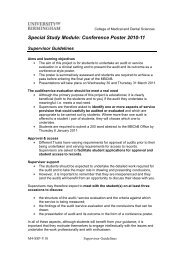Contents - College of Medical and Dental Sciences - University of ...
Contents - College of Medical and Dental Sciences - University of ...
Contents - College of Medical and Dental Sciences - University of ...
Create successful ePaper yourself
Turn your PDF publications into a flip-book with our unique Google optimized e-Paper software.
The 11 th International Workshop on KSHV & Related Agents, Birmingham, UK<br />
Clinical & Epidemiology Abstract 54<br />
DISTRIBUTION OF KSHV MICRORNA POLYMORPHISMS IN AIDS-KS, CLASSICAL<br />
KS, AND MULTICENTRIC CASTLEMAN’S DISEASE<br />
Vickie Marshall, 1 Eliza Martró, 2 Elizabeth Brown, 3 Dian Wang, 1 Alex Ray, 1 Maria<br />
Nazzarena Labo, 1 The Classical Kaposi’s Sarcoma Working Group, Robert Yarchoan, 4<br />
Jordi Casabona, 2 Rolfe Renne, 5 <strong>and</strong> Denise Whitby 1<br />
1 NCI-Frederick, Frederick, MD, USA; 2 Hospital Universitari Germans Trias i Pujol,<br />
Badalona, Spain; 3 <strong>University</strong> <strong>of</strong> Alabama at Birmingham, Birmingham, AL, USA; 4 Division<br />
<strong>of</strong> Clinical Services, NCI, NIH, Bethesda, MD, USA; 5 <strong>University</strong> <strong>of</strong> Florida Sh<strong>and</strong>s Cancer<br />
Center, Gainsville, FL, USA<br />
Abstract<br />
MicroRNAs are short regulatory RNAs <strong>of</strong> approximately 19-24 nucleotides in length that<br />
bind specifically to mRNA in a process that interferes with translation or promotes<br />
degradation. KSHV encodes twelve microRNAs, all located within the latency associated<br />
transcript which is highly expressed in KSHV-associated malignancies.<br />
We amplified, cloned, <strong>and</strong> sequenced a 2,712 bp non-coding region containing a cluster<br />
<strong>of</strong> 10 microRNAs <strong>and</strong> a 646 bp fragment <strong>of</strong> the K12/T0.7 gene which contains two<br />
microRNAs. We successfully characterized KSHV microRNA sequences from lymphocytes<br />
collected as part <strong>of</strong> two Kaposi’s sarcoma case-control studies (one AIDS-KS, one<br />
Classic–KS) <strong>and</strong> MCD clinic attendees from the NCI. We have completely or partly<br />
characterized all twelve KSHV microRNAs from a total <strong>of</strong> 37 Kaposi sarcoma cases, 21<br />
KSHV positive controls, <strong>and</strong> 8 MCD patients.<br />
Phylogenetic analysis <strong>of</strong> both regions demonstrates extreme conservation <strong>of</strong> microRNAs<br />
overall. However, several distinct polymorphisms were discovered in this study, some<br />
occurring within the mature microRNA transcript. Phylogenetic characterization <strong>of</strong> the<br />
KSHV K1 <strong>and</strong> viral microRNA sequences in this study indicated all were subtypes A/C.<br />
However, we did detect four microRNA polymorphisms we previously described as<br />
specific to KSHV viral subtypes A5/B. Some polymorphisms appear to be more common<br />
in Kaposi’s sarcoma <strong>and</strong> MCD cases than in KSHV positive controls.<br />
Our data demonstrate that most KSHV microRNAs are highly conserved suggesting that<br />
they contribute to the biological activity <strong>and</strong> possibly viral pathogenesis <strong>of</strong> KSHV.<br />
However, some KSHV microRNAs have distinct polymorphisms which may affect<br />
processing, function, <strong>and</strong> mRNA target recognition.<br />
Presenting author Email: marshall@ncifcrf.gov<br />
81















